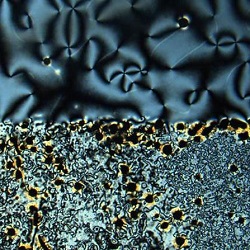Will it appeal to your curiosity if you hear that someone is going to merge together two wonder materials: one that is beautifully coloured and another that is very flat, conductive, flexible and strong?
The whole buzz in making modern displays is for ones that are flexible – televisions that can bend around walls and tablets that can be rolled like a newspaper. These can be achieved by using graphene – a very thin, strong, conductive layer of carbon atoms – and liquid crystals, which are colourful organic molecules that are already used in displays. This exciting research happens at the Engineering Department of Cambridge University and is a part of Nanotechnology DTC programme.
There has been a lot of research done since graphene’s discovery in 2004 and the Nobel Prize award in 2010. However, one specific area is not yet well understood, namely what happens when liquid crystals molecules align on graphene. The alignment effect has been proven to exist, yet there are still many doubts to how exactly this happens especially in terms of symmetry and strength of interaction. These properties need to be well understood before they can be exploited for the purpose of making devices. The prospects look bright as apart from graphene’s inherent flexibility, another potential advantage of these devices is the fast response rate to the electric field – which means that displays made of these two materials can refresh quickly and hence the image is much more natural and smooth. Good characterisation of these parameters will pave the way for working prototypes and in consequence commercial application of this technology.
The interesting thing about this work is that it tries to connect fundamental physical understanding of molecules’ alignment through interesting prototypes to manufacturing of useful devices which can improve our everyday experience with displays. What is more it is truly interdisciplinary – it involves collaboration with people form the engineering, physics and chemistry departments – a highlight of modern science where experts from many disciplines are needed to achieve a goal.

